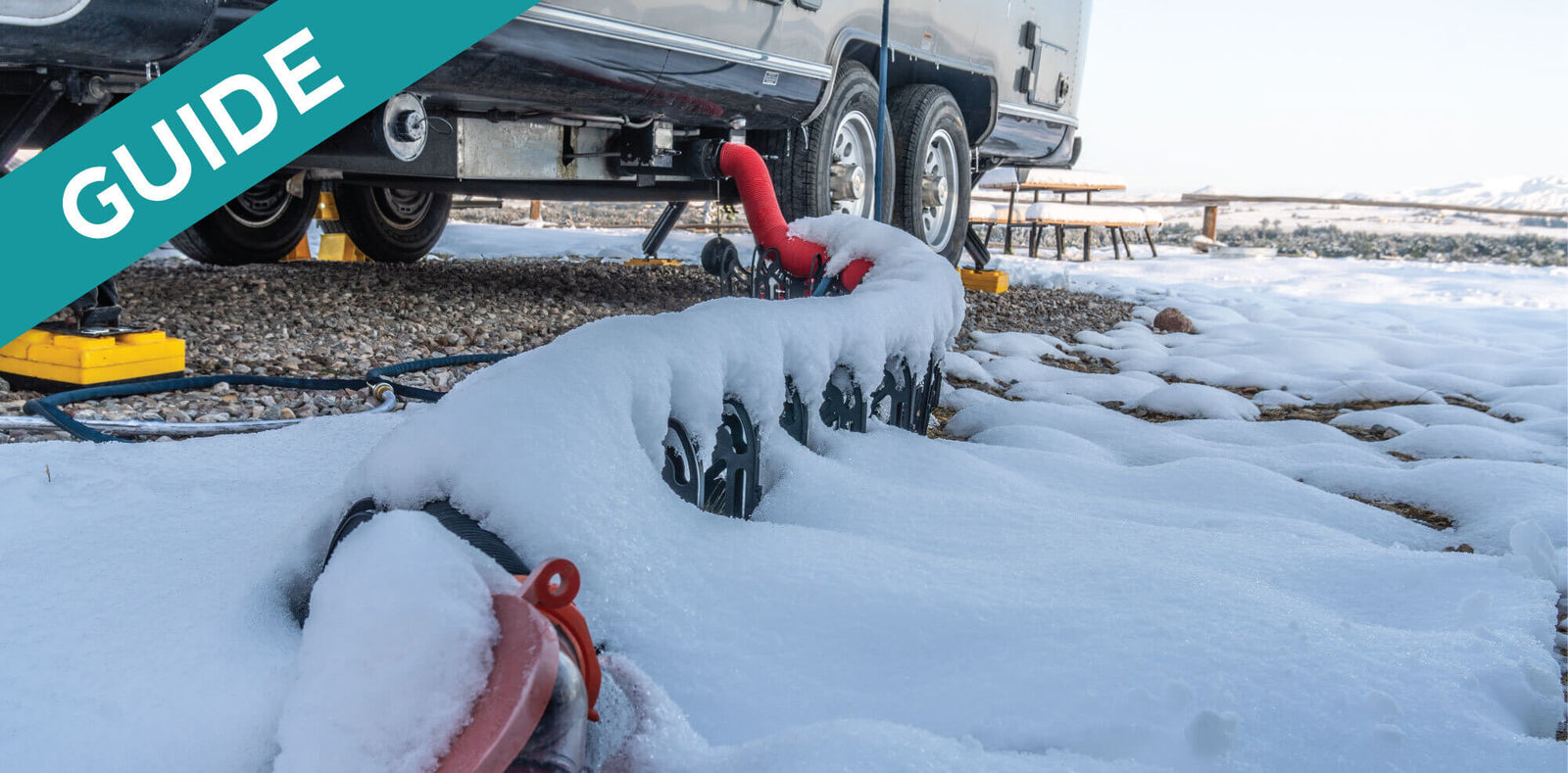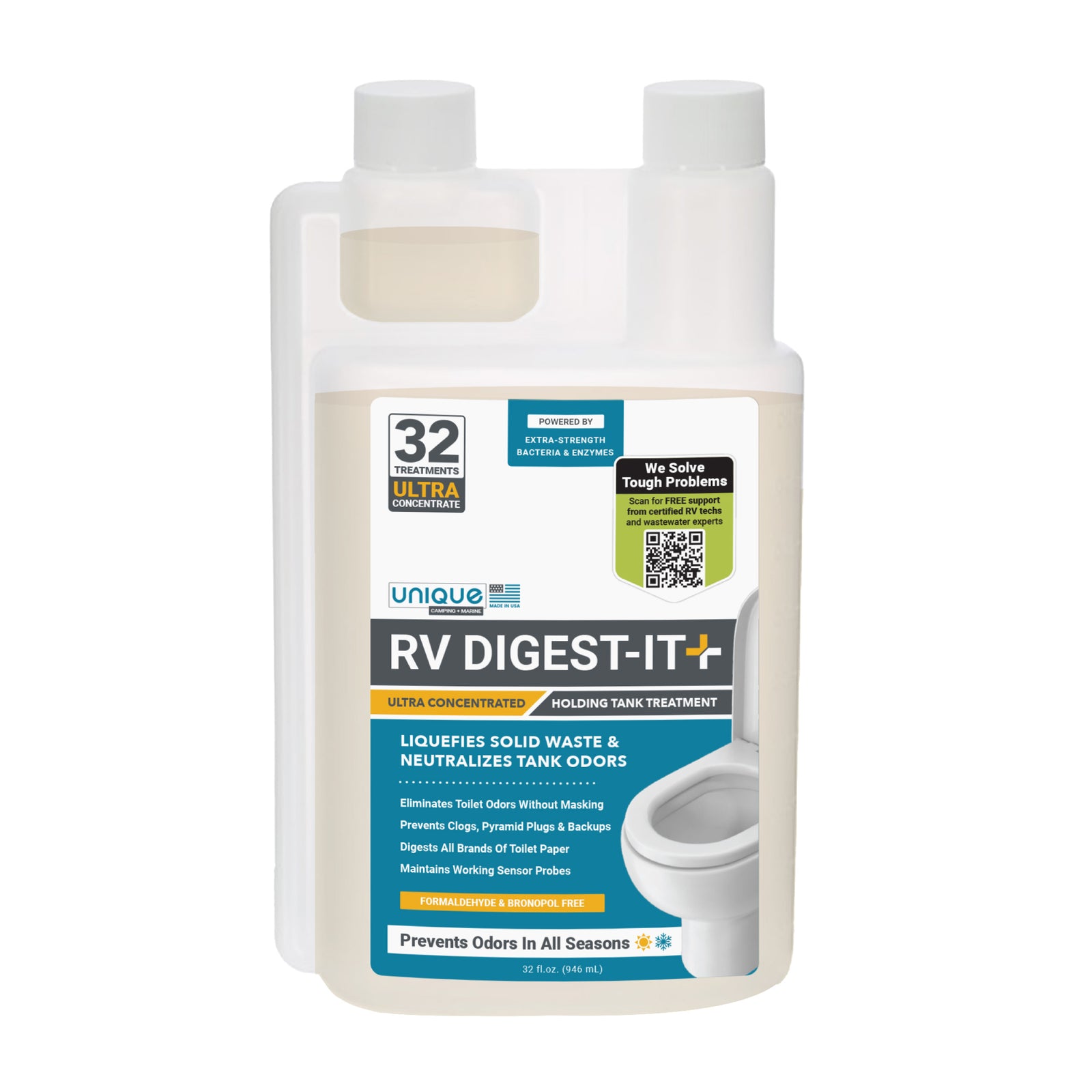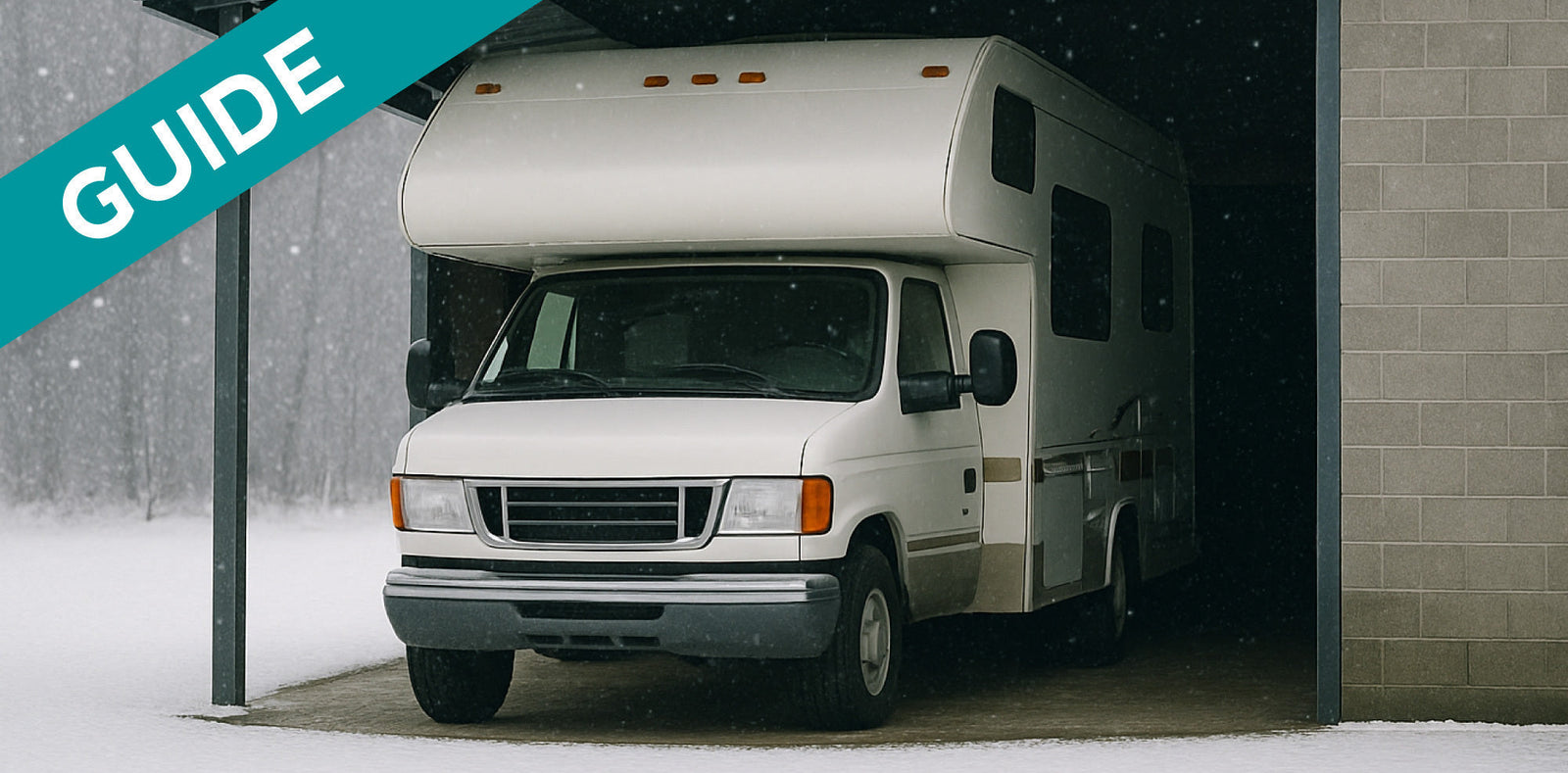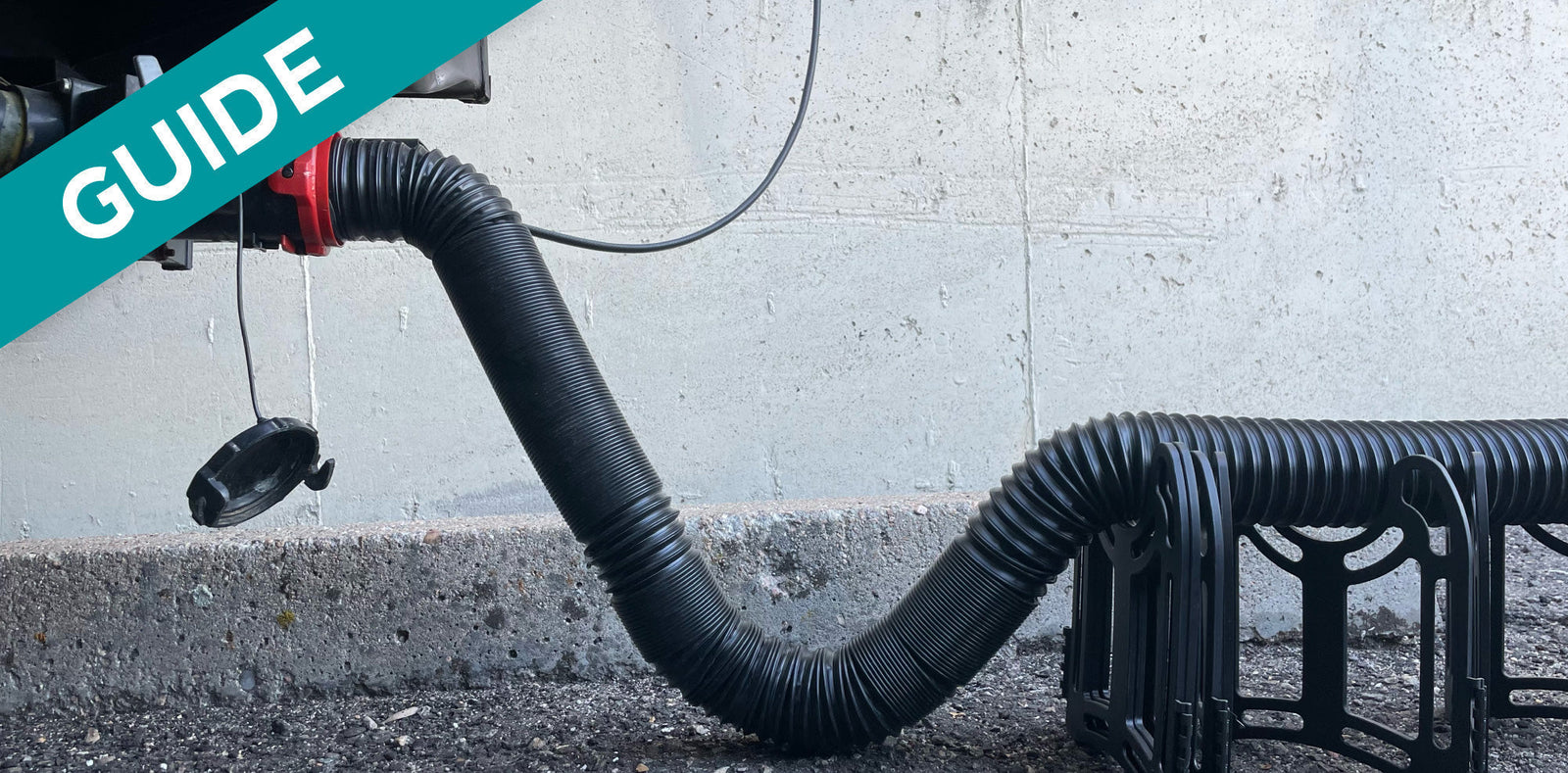
If you’re interested in camping year-round, then you’ll need to be ready to face the challenges that come with extreme weather conditions. In below-freezing temperatures, the water systems in your RV have the potential to freeze, while the interior living area can become uncomfortably chilly.
To avoid costly damages and inconvenient problems while camping during winter, it is important to be prepared. In this guide we’re going to help you understand the limits of your RV, be aware of areas most likely to freeze, and plan ahead by installing preventative measures.
If you’re already dealing with frozen pipes and tanks in your RV, refer to our helpful guide: How to Unfreeze RV Pipes and Tanks
Key Points About Insulating Your RV in Freezing Temperatures
- Four-season RVs are built for camping year-round in more extreme weather conditions, while standard three-season RVs are only designed for moderate temperatures.
- The most common areas in an RV that are likely to freeze are pipes, holding tanks, and fixtures in the water system, and they need to be protected from freezing and bursting to prevent costly damage.
- The best ways to insulate your RV from the cold include custom RV skirting, heating tape, cables, and blankets, holding tank heaters, heavy rugs, carpeting, or foam boards, reinforced window and door sealants, and window film and reflective foil coverings.
- Keeping your RV warm and preventing the plumbing systems from freezing isn’t difficult, but does require proper planning and equipment.
Some RVs Are Built for Freezing Temperatures, Some Aren’t
When you purchase an RV, it is important to consider the type of camping you’re interested in. Not all RVs are designed the same way, and there are different temperature limitations depending on the model.
Before taking your RV into freezing temperatures, it is important to consult your owner’s manual to confirm the safe temperature range for your RV. The major differences between four-seasons RVs and three-seasons RVs are insulation and cost.
Four-Seasons RVs
The most important thing to understand about four-seasons RVs is that there is no industry standard for this terminology. This means that almost any RV can be called a four-seasons RV, but the features may not line up with your needs or expectations.
Four-season or all-season RVs, while not standardized to a particular temperature range, are usually designed to handle below-freezing temperatures as low as 0-5°F [-18 to -15°C]. While these ratings mean that the RV is set up to work better in cold temperatures, the manufacturer may have only designed the RV for short-term use in freezing temperatures, and not for long-term stays or for living in full time.
For campers who intend to live in cold temperatures full time, additional aftermarket solutions may need to be installed on a four-seasons RV in order to withstand the elements for extended periods of time.
Freeze-Prevention Features in Four-Seasons RVs
Four-seasons RVs are typically more expensive because they are equipped with improved insulation and freeze-prevention features.
Enclosed Underbellies
Many are fully insulated, while others are covered in coroplast and have no additional insulation. Some enclosed underbellies have ducts that branch off the main trunk of the duct work from the furnace to blow hot air into the subfloor area, helping to keep holding tanks, waterlines, and storage areas warmer.
Superior Insulation
Insulation materials with higher R-values are used, (sometimes even utilizing a combination of materials for improved performance), and insulation is applied to the floor, roof, slide outs, external storage compartments, and all of the plumbing and heating/cooling systems.
Efficient Designs
The design itself can also help prevent heat loss, opting for radiused roof designs over the standard flat options, or double-pane windows for reduced heat loss.
Additionally, four-seasons models may insulate under carpets or wrap holding tanks with an insulating material such as AstroShield (previously known as Astro Foil). AstroShield utilizes a multi-layer design that provides a thermal barrier to improve energy efficiency in your RV.
Improved Heating
Some four-seasons RVs come equipped with heated holding tanks, heat cables or heat tape, and higher BTU (British thermal unit) heaters pre-installed.
Important Note: Four-seasons RVs may include one, a few, or all of these features, so it is important to review the specific details included in each model. This can help you determine what preventative measures you need to take in order to protect your RV in below-freezing temperatures.
Three-Seasons RVs
Standard RVs are typically designed to be comfortable in fair temperatures between 50-80°F [10-26.7°C].
Three-seasons RVs are usually less expensive than four-seasons models, particularly because they aren’t equipped with the same level of insulation or design features that are needed to withstand extreme temperatures (both hot and cold).
Bottom Line: Every RV has its limitations when it comes to freezing temperatures, and repairing the damage associated with RV fixtures and components can be inconvenient and costly. If you choose to brave the cold in your RV, preparation is key.
Areas Most Susceptible to Freezing in RVs
In freezing temperatures, it is important to keep the interior of your RV warm, and to protect all of your RV’s main components. Any part of your RV that has water in it can freeze, and as a result, your RV’s water system is most susceptible to freezing, and subsequent damage.
The RV components most likely to freeze include:
- Water Pump: Pushes water through to the lines to the sinks, shower, and toilet. Ice formation inside the pump can fracture and become badly damaged as freezing water expands.
- Fresh Water System: Fresh water lines carry water to the sinks, shower, and toilet, and bends in the lines can allow water to accumulate and freeze. Frozen lines can prevent water from moving through, or cause cracked or burst pipes.
- Fresh Water Hook-Up Garden Hose: The garden hose that delivers fresh water to your RV sits outside in the cold, allowing water to easily freeze inside. This can block access to fresh water for your RV.
- Holding Tanks: Holding tanks are at greater risk of freezing because they are usually located under the RV, or in areas that are not well insulated. Freezing can cause blocks, or even cracks or bursts. Damaged holding tanks can’t be used, and are costly to repair or replace.
- Plumbing Drain System: Includes p-traps located under sinks and showers, and lines that connect them to the holding tanks. When these lines freeze it can prevent the use of important RV fixtures, and can cause leaks or water damage. Frozen p-traps can prevent their primary function, allowing foul odors to enter the RV living space.
- Sewer Discharge Plumbing: The sewer discharge plumbing and valves can freeze if there is water inside the pipes, which can cause blockages, burst pipes, and backups in your RV.
- Propane Tanks: Below-freezing temperatures can reduce, or completely inhibit, propane tank pressure levels, which can prevent you from being able to use your furnace (making an already bad situation worse).
How to Prevent Your RV From Freezing: Expert Tips
There are numerous ways to keep your camper’s water systems functioning properly, and to keep the interior toasty warm. While the methods aren’t complicated, they do require some preparation to be effective.
Heating RV Holding Tanks, Pipes, and Hookup Hoses
The location of your RV holding tanks and pipes can directly affect how freezing temperatures will impact them. Some RVs have holding tanks positioned above floor level (typically freshwater holding tanks), where the built-in furnace, electric heater, or portable floor heater used to heat the living space will keep the tanks thawed. However, when tanks are positioned outside or underneath the RV, they are more susceptible to freezing.
1. RV Skirting
RV skirting is a protective barrier used to shield your RV from the elements by preventing cold air and wind from circulating underneath it, and causing water and plumbing systems to freeze. Custom RV skirting can be made from a variety of materials, so it’s important to understand what is best for your situation.
Vinyl
Vinyl RV skirting is a popular choice because it is affordable, lightweight, long-lasting, and easy to install. It is also more portable than other options, making it less of a hassle if you plan to relocate every few weeks.
You can choose between standard vinyl, insulated vinyl, and vinyl with sewn-in backing, and the major thing is to choose vinyl that can withstand harsh environments. There are companies who professionally install vinyl skirting, or you can purchase and install a vinyl skirting kit yourself if you’re on a budget.
Plywood & Insulation Boards
Plywood and insulation board RV skirting is a permanent or semi-permanent solution, because it is heavy, and not as convenient or easy to move and store in an RV. Sheets of plywood or insulation boards can be cut to custom fit the underside of your camper, effectively blocking cold air and protecting the underside of your RV from the elements.
Plywood and insulation boards are a durable and sturdy option, but require a significant investment in materials and time. After the plywood or insulation boards are cut, you also need to choose a method to secure it to the RV, which can involve building additional framing.
Foam Boards
Foam board RV skirting is inexpensive, lightweight, and can also be cut to fit the shape of your camper. When choosing foam boards, it is important to consider the type of foam, particularly for its durability and moisture resistance.
Foam board RV skirting is available in several types including:
- Expanded Polystyrene (EPS): Most cost-effective, environmentally friendly, but only offers moderate moisture resistance.
- Extruded Polystyrene (XPS): Stronger than other options, higher R-value (resistance to heat transfer) compared to EPS, highly moisture resistant with minimal absorption, and can withstand freeze-thaw cycles.
- Polyisocyanurate (Polysio): Superior thermal performance, fire resistant, environmentally friendly, and offers excellent moisture resistance, particularly with foil facings.
- Polyurethane: Most expensive, but offers excellent air sealing capabilities and adhesion to most building materials, and incredible moisture resistance with closed-cell varieties.
Make sure to choose foam boards based on your individual needs, considering their durability, thermal properties, and ability to resist moisture.
2. Heating Tape
Electric heat tape can be applied to the RV water supply and drain pipes to prevent freezing. Heating tape is usually made of silicone or a poly blend, flatter than heating cables, and easy to wrap around various pipes and hoses in the RV’s plumbing system. Heating tape tends to come at a higher cost ($100 or more on average).
It is crucial to select heating tape that is rated for your pipe materials, because if you select the wrong type, you run the risk of melting the pipes and causing a potential fire hazard. Some heat tapes come with built-in thermostats that automatically turn the tape on and off to maintain consistent temperatures, and to conserve energy.
3. Heating Cables
Heating cables can be used on pipes and hoses and include a built-in heating element to prevent plumbing components from freezing. Heating cables look similar to extension cord cables (more rounded as opposed to flat), and are usually less expensive than electric heat tape. Some heating cables come with a standard three-prong cord, others are trace cables that must be directly wired into the electrical source.
Typically, heating cables indicate the materials they are compatible with, and most work well with rigid plastic (PVC pipe) without melting them. Heating cables often include a thermostat that detects when freezing temperatures are present, allowing them to work without needing to be monitored.
4. Holding Tank Heaters & Blankets
Generally used for the holding tanks, heating blankets are much like electric blankets you might use in your home. The difference is that they’re designed to withstand the elements, and put out higher levels of heat to prevent your holding tanks from freezing.
These tank heaters are typically applied directly to the tank, often as a self-adhesive pad, and are designed to evenly transfer heat to the tank. They usually have sensors that will turn on the heat when they detect temperatures below a certain threshold. Holding tank heaters use a lot of energy, and if you aren’t on hookups, it is important to closely monitor your batteries.
For safety reasons, tank heater and blanket installation should be handled by a certified RV technician or service center, and usually involves cleaning the tank surface, adhering the pad to the tank, and connecting the electrical wires that are protected by conduit or insulation wrap.
Important Note: RV tank heaters and heating blankets are very helpful for freeze prevention, but are not typically rated for unfreezing an already frozen holding tank. It is best to turn on these devices before temperatures drop below freezing.
6. Hook-Up Hose & Sewer Discharge Line
Hook-up hoses and sewer discharge lines that are left out in freezing temperatures can easily freeze, causing damage to the hose or valve, and making it impossible to get water or dump when you need to.
Using a hose with a built-in heater can prevent freezing while allowing you to stay hooked up to the water source or sewer port in freezing conditions. There are also aftermarket heated knife valve kits (sewer and gray tank termination valves) that can help keep valves operating at optimal temperatures, and maintain their integrity by preventing them from freezing.
Alternatively, disconnecting and storing hook-up lines until you need them can keep them protected from freezing, and will allow you to refill your freshwater or dump your tanks when you need to.
7. Propane Heat Jacket
A propane heat jacket is a cover designed to generate and circulate heat to keep your propane at an ideal temperature regardless of freezing conditions.
Propane tank heat jackets are often made of PVC-coated polyester or nylon for water resistance and durability. They also usually include insulating layers like closed-cell foam, fiberglass, or Nomex. The heat itself is generated by the electric heating elements that are normally insulated with silicone and embedded in the jacket.
Insulating the RV’s Interior
While keeping important RV components functioning properly is important, finding efficient ways to keep the interior living space warm is also crucial when camping in freezing temperatures.
1. Electric Heaters
If you’re on a full hookup campground with a power supply, running electric heaters can help keep the inside of your RV nice and warm. Many electric heaters offer high-temp and tip-over protection, adding to the overall safety.
We recommend oil filled, radiator-style heaters because of the thermostat which can cycle the heat, and even automatically turn off, if left unattended. Since they have no exposed heating elements, they can also be a safer alternative compared to ceramic tower heaters.
2. Heavy Rugs, Carpeting, and Foam Boards
Putting down heavy rugs, carpeting, or foam boards on the floor of your RV can add an additional layer of insulation. This can trap heat inside of the RV, prevent heat loss, block cold drafts, and make the interior cozier.
Adding insulation to the floors of your camper can also reduce energy consumption by allowing your heating system to work less, and enhance comfort by keeping floors warmer, muffling noise, and preventing slips.
3. Reinforce Sealants
Prior to camping in extremely cold conditions, we recommend checking the seals on your windows and doors. As you use your RV, temperatures fluctuate throughout the seasons and cause rubber seals and weather stripping to become dried out and brittle.
Weak seals will allow heat to escape, and cold air to seep in. You’ll want to check for cracks, gaps, or
separation of the sealant. To reinforce the sealants, prepare the surface by removing old, failing sealant,
cleaning
the area, and letting it dry completely. Afterwards, you can use a caulking gun to apply RV-specific sealant in a
thin, continuous bead along the seam or crack.
4. Window Film & Reflective Foil Coverings
To combat heat loss through windows and skylights, window film and reflective foil coverings can be used to help keep warm air trapped inside, and prevent it from coming in direct contact with the cold surface of the windows.
Heat loss through windows can be considerable — in fact, according to the Department of Energy, about 30% of a standard home’s heating energy is lost through windows. In RVs this number is similar, if not even more significant, depending on the quality of the windows and whether they are single- or double-pane.
Skylights generally cause even further heat loss, as the warm air rises and comes in contact with the cold surface of the skylight. This cools the air, causing it to drop, and is then replaced by the warmer air from below. This circulation of air is known as a convective heat loop, and results in increased heat loss.
Keeping Your RV Safe & Warm: Be Proactive
One of the best things you can do to keep your RV warm, and prevent major components from freezing, is to think ahead. Once temperatures have dropped significantly, the interior of the RV is already chilly, and the RV water systems begin to freeze — it’s too late.
Raising the temperature of an RV is difficult in below-freezing temperatures. While it is possible, it will require more time, effort, and energy, which are all things you want to preserve during cold-weather camping.
Instead, knowing your RV’s limits, installing preventative measures like RV skirting and heating cables before your trip, ensuring you have proper insulation, and turning on the furnace and holding tank heaters ahead of time, can help keep you comfortable and safe while temperatures drop outside.
For more expert advice about camping in freezing temperatures, reach out to the professional Customer Service Team at Unique Camping + Marine for fast and friendly help and support.

Prevent Common Problems In Your Tanks!
From misreading sensors, preventing clogs, or eliminating odors, we've got you covered no matter how you camp! All our best holding tank tips and trick information plus more can be found conveniently in one place when you download our FREE Unique Method Field Guide PDF. Achieve holding tank bliss today!
Get The Free Download Get The Free Download



